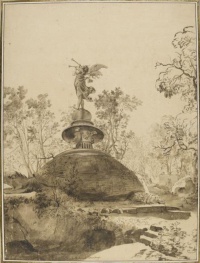Folly
From The Art and Popular Culture Encyclopedia

|
"For I am, as you see, that true and only giver of wealth whom the Greeks call Moria, the Latins Stultitia, and our plain English Folly."--The Praise of Folly (1511) by Erasmus |
|
Related e |
|
Featured: |
In architecture, a folly is an extravagant, frivolous or fanciful building, designed more for artistic expression than for practicality.
The term comes from the fact that such structures have often been dubbed "[name of architect or builder]'s Folly", in the sense of foolishness, fun or light-heartedness. Particularly because some follies were built by one individual alone, such as the massive complex by Ferdinand Cheval.
However, very few follies are completely without a practical purpose. Apart from their decorative aspect, many originally had a use which was lost later, such as hunting towers. Headley & Meulenkamp in Follies Grottoes & Garden Buildings defined a folly as a "misunderstood building".
Follies are often found in parks or large grounds of houses and stately homes. Some were deliberately built to look partially ruined. They were especially popular from the end of the 16th century to the 18th century.
Contents |
Examples
Follies are found worldwide, but they are particularly abundant in Great Britain. See also.
Australia
- Ballandean Pyramid Ballandean, Queensland
- Big Bridge at the entrance to Peter Warren Cars at Warwick Farm, New South Wales
- Big Banana, Coff's Harbour New South Wales
- The Golden Guitar Tamworth, New South Wales
France
- Chanteloup Pagoda, near Amboise
- Désert de Retz, folly garden in Chambourcy near Paris, France (18th century)
- Parc de la Villette in Paris has a number of modern follies by architect Bernard Tschumi.
- Ferdinand Cheval in Châteauneuf-de-Galaure, built what he called an Ideal Palace, seen as an example of naive architecture.
- Hameau de la reine, in the park of the Château de Versailles
Germany
Hungary
- Bory Castle at Székesfehérvár
- Taródi Castle at Sopron
- Vajdahunyad vára in the City Park of Budapest
India
Ireland
- Carden's Folly
- Casino at Marino
- Conolly's Folly
- Killiney Hill, with several follies
- Larchill in County Kildare, with several follies
- Powerscourt Estate, which contains the Pepperpot Tower
- St Anne's Park, which contains a number of follies
- The Wonderful Barn
Italy
- The Park of the Monsters Bomarzo Gardens
Russia
- Ruined towers in Peterhof, Tsarskoe Selo, Gatchina, and Tsaritsino
- Creaking Pagoda and Chinese Village in Tsarskoe Selo
- Dutch Admiralty in Tsarskoe Selo
Ukraine
- Swallow's Nest near Yalta
United Kingdom
- Ashton Memorial, Lancaster, England
- Beckford's Tower, Somerset, England
- Broadway Tower, The Cotswolds, England
- Bettisons Folly, Hornsea, England
- Black Castle Public House, Bristol, England
- Brizlee Tower, Northumberland
- The Cage at Lyme Park, Cheshire, England
- The Castle at Roundhay Park, Leeds, England
- Clavell Tower, Dorset, England
- Clytha Castle Monmouthshire
- The Caldwell Tower, Lugton, Renfrewshire, Scotland
- Dunmore Pineapple, Falkirk, Scotland
- Faringdon Folly, Faringdon, Oxfordshire
- Flounder's Folly, Shropshire, England
- The Folly Tower at Pontypool, Wales
- Fonthill Abbey, Wiltshire, England
- The Forbidden Corner, Yorkshire, England
- Fort Belvedere, Surrey, England
- Freston Tower, near Ipswich, Suffolk
- Garrick's Temple to Shakespeare, Hampton
- Gothic Tower at Goldney Hall, Bristol
- The Great Pagoda at the Royal Botanic Gardens, Kew, London¨
- Gwrych Castle, one of Europe's largest follies, Abergele, North Wales
- Hadlow Tower, Hadlow, Kent, England
- Hawkstone Park, follies and gardens in Shropshire, England
- Hume Castle, Berwickshire, Scotland
- Horton Tower, Dorset, England
- King Alfred's Tower, Stourhead, Wiltshire, England
- Mow Cop Castle, Staffordshire, England
- National Monument, Edinburgh, Scotland
- Old John, Bradgate Park, Leicestershire, England
- Penshaw Monument, Penshaw, Sunderland, England
- Perrott's Folly, Birmingham, England
- Pope's Grotto, Twickenham, south west London, England
- Portmeirion, Wales
- Racton Monument, West Sussex, England
- The Ruined Arch at the Royal Botanic Gardens, Kew, London
- Rushton Triangular Lodge, Northamptonshire (16th century)
- Severndroog Castle, Shooter's Hill, south-east London
- Sham Castle, Bathwick Hill, Bath, Somerset[1]
- Two of the follies in Staunton Country Park have survived until the present day
- Stowe School has several follies in the grounds
- Sway Tower, New Forest, England
- Tattingstone Wonder, near Ipswich, Suffolk
- The Temple near Castle Semple Loch, Renfrewshire, Scotland
- Wainhouse tower, the tallest folly in the world, Halifax, England
- Wentworth Follies, Wentworth, South Yorkshire
- Williamson's tunnels, probably the largest underground folly in the world, Liverpool, England
- Wilder's Folly, Sulham, Berkshire, England
- McCaig's Tower, Oban, Argyle and Bute, Scotland
United States
- Bancroft Tower, Worcester, Massachusetts
- Belvedere Castle, New York City
- Bishop Castle, outside of Pueblo, Colorado
- Cabazon Dinosaurs, Cabazon, California
- Italian Barge, Villa Vizcaya, Miami, Florida
- Körner's Folly, Kernersville, North Carolina
- Lawson Tower, Scituate, Massachusetts
- Lucy the Elephant, Margate City, New Jersey
See also
See also

